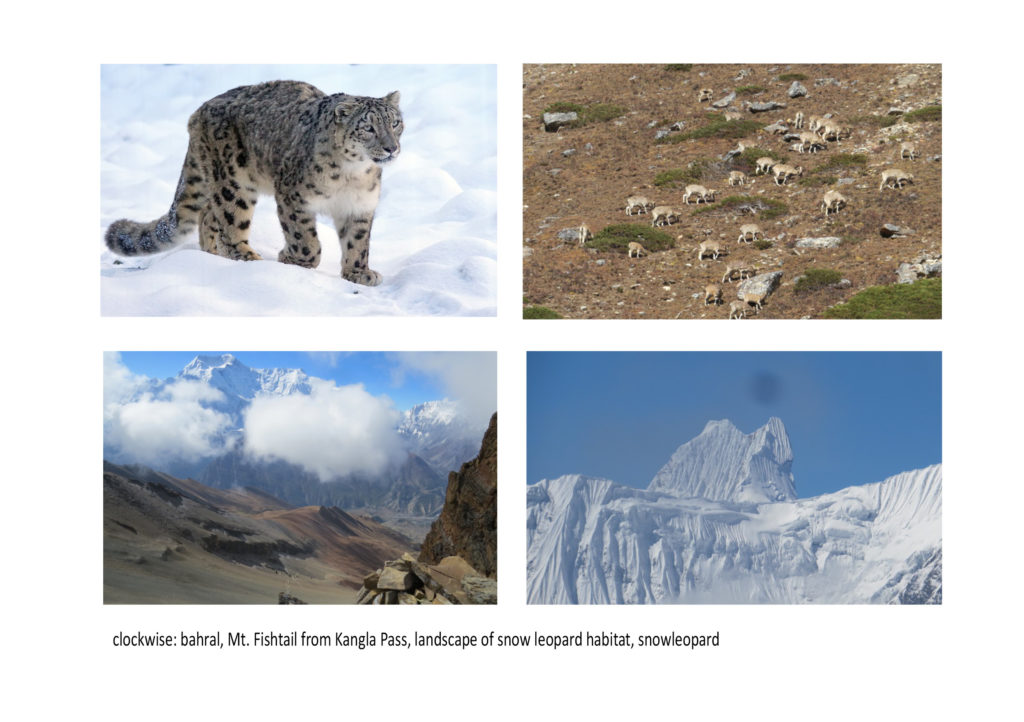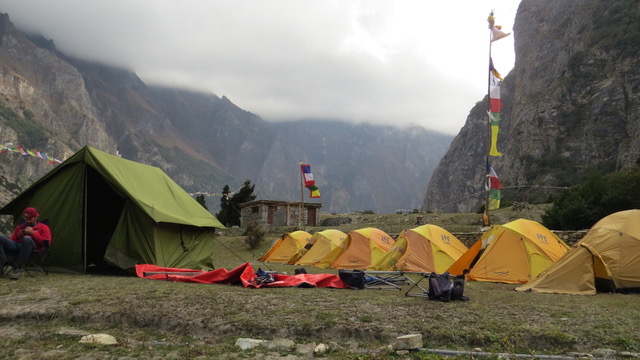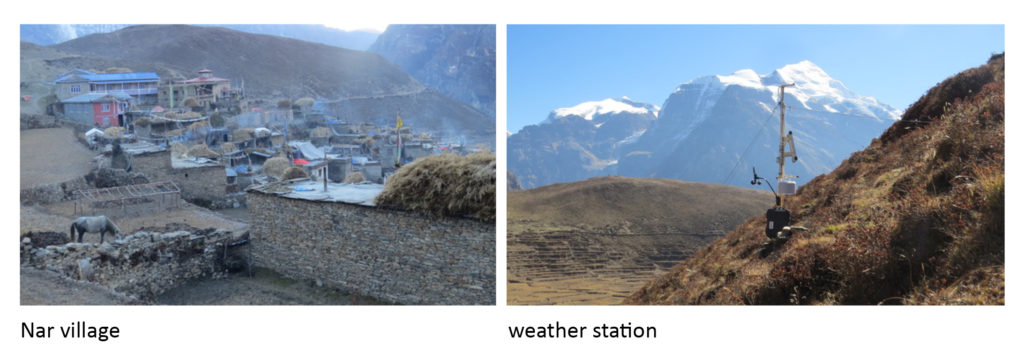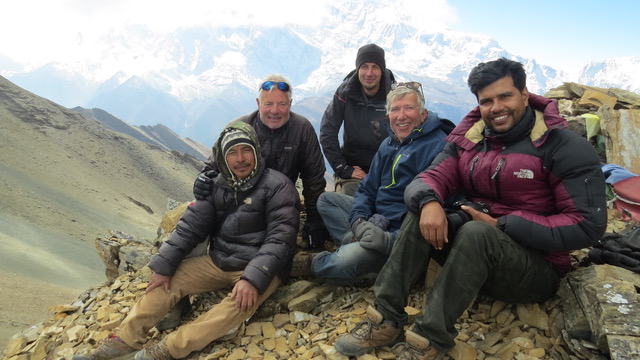S
now leopard (Panthere unica) is a close family member of tiger (Panthera tigris). Although HTF is mainly focussing on the 2xT programme, NTNC has asked us to support specific research on the snow leopard as well.
Ashok Subedi, one of NTNC’s conservation officers, is working on the ‘mountain ghost’.
From 1 to 18 October 2018, the Nar-Phu valley of Manang was visited to see whether this area is suitable for research on snow leopard. See: https://www.youtube.com/watch?v=6jws9QjVvgQ&t=21s
I completed seven years at the National Trust for Nature Conservation (NTNC) as a conservation officer. As a NTNC employee, I first visited Manang in 2012 in search of the mountain ghost; the snow leopard. I spent several nights in a tent in search of this fascinating cat. The days were windy and nights are chilling cold. Then the question arose in my mind how the snow leopard and its most important prey animal bharal (Pseudois nayaur) can survive in such an extreme climatic condition. See: https://www.youtube.com/watch?v=e_jW2Qm0nuM and also https://www.youtube.com/watch?v=Uj0EVT-Ekog
It is very hard for a human being even to spend a single night in the extreme climate of the high Himalayas but the snow leopard is living here permanently.
The question was continued for several years. Luckily, I met the globally recognized leading ecologist prof. dr. Herbert Prins from Wageningen University. He was encouraging and inspired me for generating new ideas. When we met for the fist time, he suggested to develop an artificial model of snow leopard and its main prey, the bharal and to install weather stations to understand the role of the environment to maintain the body temperature of both prey and predator. Finally, the question led me to a Ph.D. and brought me to Wageningen University. My Ph.D. will find the answers to three major questions; the first one is what is the resource ecology of snow leopard and bharal and the second is what is the implication of dramatic landscape dynamics currently taking place on snow leopard and bharal habitat. The third one is what is the role of the environment in maintaining the body temperature of both snow leopard and bharal.
My Ph.D. will find the answers to three major questions; the first one is what is the resource ecology of snow leopard and bharal and the second is what is the implication of dramatic landscape dynamics currently taking place on snow leopard and bharal habitat. The third one is what is the role of the environment in maintaining the body temperature of both snow leopard and bharal.
I have chosen the Nar-Phu valley of Manang, the hidden paradise and habitat of the mountain ghost to find answers to these research questions. The research will contribute to address important conservation issues of the globally vulnerable snow leopard.
Human-snow leopard-conflict, changing landscape dynamics and climate change are the major conservation issues of the snow leopard. My research will be focused on finding the quantity and quality of forages for the bharal and assess the availability of this prey for the snow leopard so as to understand whether resource limitation is the cause of predation on live stock. My research will also explore the implication of changing landscape dynamics on the snow leopard habitat. Similarly, the exploration of thermal ecology helps to understand the role of the environment to maintain the body temperature of snow leopard and its main prey and how this might change with changing climate. In addition, snow leopard conservation depends on the healthy population of prey (bharal) and prey depends on the forage.
Based on integrated research on the prey-predator, the resources, landscape dynamics, and thermoregulation recommendations can be formulated how the snow leopard protected areas should possibly be re-designed.
Our explorative trek to the northern part of Annapurna Conservation Area, the Nar-Phu valley of Manang was quite exciting and informative. The expedition team comprised of prof. dr Herbert Prins (Wageningen University), Egbert van der Pol (Himalayan Tiger Foundation), prof. dr. Jasper Griffioen (Utrecht University). Yorick Liefting (Wageningen University), OM Bahadur Gurung and myself (both local staff from National Trust for Nature Conservation, Annapurna Conservation Area Project.
It was an eighteen days expedition with a mission to explore the landscape of the snow leopard and to brainstorm about the Ph.D. research questions. Our expedition started in Besisahar, the entrance gate to Annapurna Conservation Area. The snow leopard home starts from Meta in Nar-Phu valley, Manang located about 3.500m above sea level. It took 3 days for us to reach the snow leopard habitat, an overwhelming landscape with sparse vegetation of pinus, betula, abies, junipers and berberis in the lower mountains and complete domination of graminoids, bare soil and snow in the high mountains.

Our first night was at Mahendrapul near the Sartek Thrangu and Choepel Ling gompas. As per the monks, roaring sound of this fascinating cat is very common in that area but we didn’t get the opportunity to hear one. But we saw many scats and scraps around the monasteries so are sure that this big cat is around. We had a plan prepared at Wageningen University for the search of suitable locations to install weather stations and artificial animals. We selected a first pair of locations (north and south slopes) close to the monasteries at 3600m.
On the fifth day of our expedition, we reached Nar village, selected a second location nearby and installed there our first weather station at 4.200 m (north slope). This weather station will provide key information on the local climate that will be used to further define the specs of the other weather stations and the artificial animals.

During our climb higher up in the mountains we encountered dozens of snow leopard scats and several herds of bharal. Yaks were jumping and fighting on the way, local people were following to collect their dung for burning to keep their house warm and safe from the cold winter nights.
On the eighth day, we identified a fourth location for a weather station at Kangla Phedi (4.600m). It was again windy and chilling cold, the experience is the same as seven years ago. We spent three nights at Kangla Phedi. Every day huge herds of bharals appeared with sunrise and disappeared with sunset. Local women said that a week before they saw the snow leopard on the top of a small hill just 200m away from our campsite. Therefore, our cameras were to instantly capture the snow leopard but unfortunately we were not lucky enough to catch this big cat.
 Our climb to the highest location started early in the morning with a mild headache and cold and dry wind. We climbed up to Kangla Pass (5320 m) and from there identified the fifth location at 5.200m. My mind was full of enthusiasm to be in the mountain again and I felt a strong determination to continue research on the mountain ghost. At the summit of Kangla, every heartbeat was kindly acknowledging the helping hands of a team, Himalayan Tiger Foundation for financial support and the Wageningen University for providing me an academic platform. We followed the same trail back to Besisahar to check the performance of the Nar-weather station and to collect the first data. This journey was the beginning of a still long way to go to get the answers to our research questions
Our climb to the highest location started early in the morning with a mild headache and cold and dry wind. We climbed up to Kangla Pass (5320 m) and from there identified the fifth location at 5.200m. My mind was full of enthusiasm to be in the mountain again and I felt a strong determination to continue research on the mountain ghost. At the summit of Kangla, every heartbeat was kindly acknowledging the helping hands of a team, Himalayan Tiger Foundation for financial support and the Wageningen University for providing me an academic platform. We followed the same trail back to Besisahar to check the performance of the Nar-weather station and to collect the first data. This journey was the beginning of a still long way to go to get the answers to our research questions

HTF received financial support from the INNO Fund for initiating innovative research on snow leopard, managed by WWF Netherlands.
![]() Snow Leopard Adventures in The Hague organised and sponsored the scientific trek to the Nar-Phy Valley enabling the research team to successfully explore snow leopard habitat.
Snow Leopard Adventures in The Hague organised and sponsored the scientific trek to the Nar-Phy Valley enabling the research team to successfully explore snow leopard habitat.

